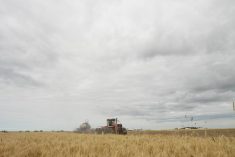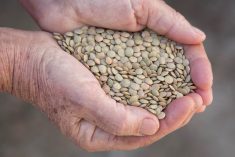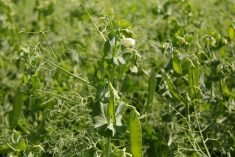Winnipeg | Reuters — Canada’s western farm belt, dogged by excessive rain in some areas this spring, is now facing parched conditions in others, threatening wheat and canola crops, crop analysts say.
A large area of southern Saskatchewan and southwestern Manitoba has received less than 40 per cent of normal precipitation during the 30-day period leading up to June 5, according to Agriculture and Agri-Food Canada.
Much of east-central Alberta and west-central Saskatchewan has the opposite problem, having collected more than double the usual amounts of precipitation.
Read Also

India slaps 30 per cent import duty on yellow peas
India has imposed a 30 per cent duty on yellow pea imports with a bill of lading date on or after Nov. 1, 2025.
The southern Prairies need 0.5 to 1.5 inches of rain soon — “a $1 million-dollar” shower to accelerate growth, said Dave Reimann, grain market analyst at Cargill.
Spring wheat and canola in Saskatchewan, the biggest provincial producer of those crops, are seven to 10 days behind their normal development, despite being planted on time this spring, said Shannon Friesen, cropping management specialist for the provincial government.
High winds have compounded the problem, drying up what little moisture Saskatchewan and Manitoba have received.
Some crops have yet to poke through the soil and may not emerge at all without a significant rain in the next week, Friesen said, adding: “Some of those crops could be done.”
Minneapolis spring wheat futures have gained about 12 per cent since mid-May on concerns about hot, dry weather in the northern U.S. Plains, which border the southern Canadian Prairies.
Environment Canada is forecasting hot, dry weather for most of the next week across the southern Prairies, although some dry parts of Manitoba and Saskatchewan may get periodic showers.
Canada is a major wheat exporter and the biggest global grower of canola, used to make vegetable oil.
Elsewhere, farmers who are planting later than normal may decide to sow additional acres of short-season crops, such as barley and oats, said FarmLink Marketing Solutions senior market analyst Neil Townsend.
Other farmers in Alberta’s wet Peace River region may expand canola plantings at the expense of spring wheat, which takes longer to grow, said Neil Arbuckle, national sales lead at the Canadian unit of seed and chemical dealer Monsanto.
“Although canola is costlier, even with a wheat price rally, canola could provide a higher return given the excellent yields farmers have been experiencing recently,” Arbuckle said.
Statistics Canada is scheduled to estimate Canadian plantings on June 29.
— Rod Nickel is a Reuters correspondent covering the agriculture and mining sectors from Winnipeg.












